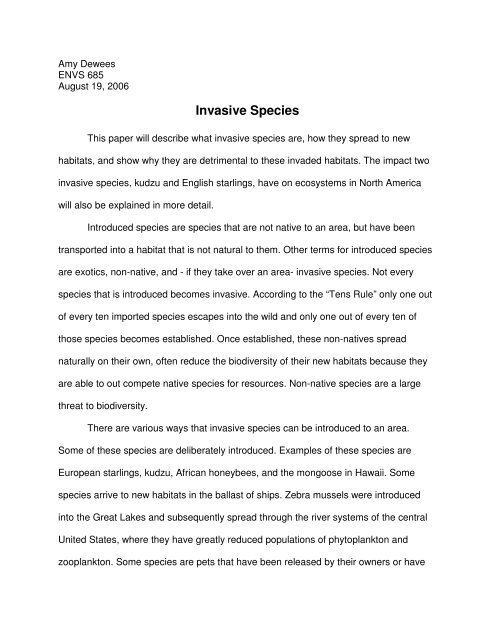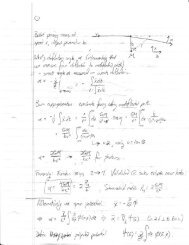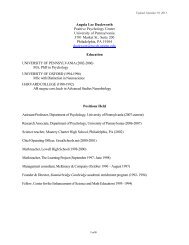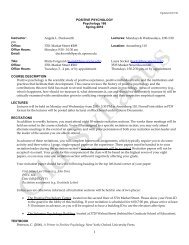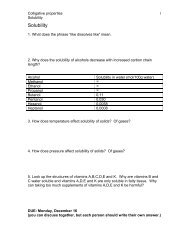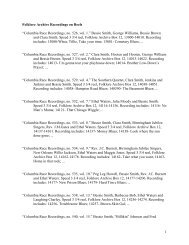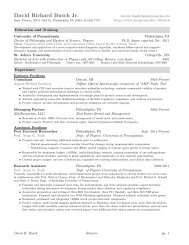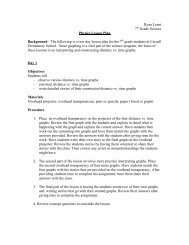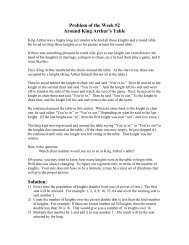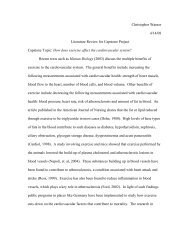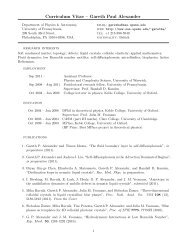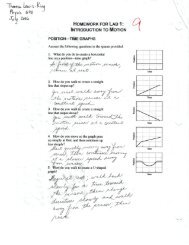Invasive Species Paper
Invasive Species Paper
Invasive Species Paper
You also want an ePaper? Increase the reach of your titles
YUMPU automatically turns print PDFs into web optimized ePapers that Google loves.
Amy Dewees<br />
ENVS 685<br />
August 19, 2006<br />
<strong>Invasive</strong> <strong>Species</strong><br />
This paper will describe what invasive species are, how they spread to new<br />
habitats, and show why they are detrimental to these invaded habitats. The impact two<br />
invasive species, kudzu and English starlings, have on ecosystems in North America<br />
will also be explained in more detail.<br />
Introduced species are species that are not native to an area, but have been<br />
transported into a habitat that is not natural to them. Other terms for introduced species<br />
are exotics, non-native, and - if they take over an area- invasive species. Not every<br />
species that is introduced becomes invasive. According to the “Tens Rule” only one out<br />
of every ten imported species escapes into the wild and only one out of every ten of<br />
those species becomes established. Once established, these non-natives spread<br />
naturally on their own, often reduce the biodiversity of their new habitats because they<br />
are able to out compete native species for resources. Non-native species are a large<br />
threat to biodiversity.<br />
There are various ways that invasive species can be introduced to an area.<br />
Some of these species are deliberately introduced. Examples of these species are<br />
European starlings, kudzu, African honeybees, and the mongoose in Hawaii. Some<br />
species arrive to new habitats in the ballast of ships. Zebra mussels were introduced<br />
into the Great Lakes and subsequently spread through the river systems of the central<br />
United States, where they have greatly reduced populations of phytoplankton and<br />
zooplankton. Some species are pets that have been released by their owners or have
escaped from captivity. The gypsy moth escaped from a Boston laboratory and has<br />
devastated forests in Pennsylvania and New Jersey. The nutria was brought into North<br />
America from South America to be used in fur trade, but the efforts were unsuccessful<br />
and the nutria were released. Since their release in 1899, they have spread into 22<br />
states. Various species can be spread into new habitats by being carried with cargo.<br />
Norway rats, native to Asia, can now be found throughout the world.<br />
Loss of biodiversity is the largest ecological threat associated with introduced<br />
species. Introduced species can carry new diseases to which native species have no<br />
immunity. An example is the chestnut blight, a fungus that decimated the American<br />
chestnut. Chestnut blight is believed to have been carried by Chestnut trees imported<br />
from Asia. Introduced species may also prey upon native species, reducing their<br />
numbers. An example of this can be found on Guam, where the brown tree snake has<br />
devastated the native bird species which evolved without the influence of snakes and,<br />
as a result, had no defenses against snakes. Five of the eight native species have<br />
become extinct because of these (accidentally) introduced snakes. Introduced species<br />
may simply out-compete native species because the factors that control their<br />
populations in their native habitats, such as predators, parasites or other pathogens,<br />
climate conditions or geologic formations, are not present.<br />
Kudzu (Pueraria Montana) is sometimes called the “vine that ate the south,”<br />
“mile-a-minute vine,” and “foot-a-night vine.” It is a semi-woody, climbing, perennial vine<br />
that is in the pea family. It is a deciduous plant with broad leaves that can measure up<br />
to four inches across. It produces purple flowers and seeds in pods. It is indigenous to<br />
Southern and Eastern Asia. In its natural habitat, numerous natural enemies, including
species of insect and fungus, keep the population in check. Kudzu was introduced to<br />
the United States at the Philadelphia Centennial Exposition in 1876 and was promoted<br />
as an ornamental plant and forage crop. In 1935 the Soil Conservation Service began<br />
promoting its use to stop soil erosion along irrigation ditches, farmland, and railroad<br />
beds. In 1953, the United States Department of Agriculture recognized it as a pest weed<br />
because of its prolific spread. It can be found in much of the Southeastern United<br />
States, with severe infestations in Mississippi, Alabama, and Georgia, where it can grow<br />
almost anywhere over almost anything; along road banks, fields, forests, over buildings,<br />
roads, and telephone poles. Under the best conditions, it can grow as much as a foot a<br />
day. Its success in the United States can be attributed to various factors, including a<br />
lack of natural enemies. In its natural habitat in China, at least 25 species of insects<br />
have been found to feed on kudzu as well as six fungal pathogens that attack it. No<br />
such enemies are known to exist in the United States but studies are being conducted<br />
to determine if some of these insects or fungi from China could be introduced to help<br />
control the spread of kudzu in the United States. People in China also use it as a source<br />
of medicine and food. It produces large tubers, similar to potatoes that have various<br />
uses. Another reason for its success is its ability to reproduce. In the United States,<br />
kudzu produces seeds that are usually not viable because there are no insects that<br />
pollinate the flowers, but it is very effective at using vegetative means for reproduction.<br />
It puts out runners that root and grow. It produces large tubers that can survive repeated<br />
applications of herbicides and frost. Because of its quick growth, it can take over areas,<br />
killing off other vegetation because it blocks the light needed for photosynthesis and<br />
greatly reducing the biodiversity of the area.
The English starling (Sturnus vulgaris) is also known as the European starling<br />
and the common starling. It is about the size of a robin, but the tail is smaller. They are<br />
iridescent black with hints of green and purple. English starlings develop white spots on<br />
their plumage in the fall, which fades by during the winter. In March, their bills change<br />
from black to yellow (Stevens, 1997). The English starling is native to Europe, Asia, and<br />
North Africa, but has spread throughout the world, becoming established in New<br />
Zealand, Australia, South Africa and North America. The North American starling<br />
population originated from approximately 100 birds that were released in Central Park in<br />
the early 1890’s in an attempt to introduce all the birds mentioned in Shakespeare’s<br />
works to North America. The introduction of the starlings was very successful; the<br />
current population is estimated to be 150-200 million birds. One reason for the success<br />
of the English starlings is that they are habitat generalists: they are prolific in their<br />
natural habitat and tend to form large flocks that can number over 1,000. In their natural<br />
and introduced habitats, they are able to exploit a variety of food sources, including<br />
invertebrates, fruits, and seeds; they are successful in many different habitats including<br />
fields, marshes, agricultural fields, garbage dumps, sewage treatment plants, and cities.<br />
Because of their numbers, they can be extremely destructive and will compete with<br />
livestock for their feed and strip a field of any seeds that have been sown. They also<br />
destroy berry and fruit crops. Starlings are very aggressive and will drive birds (including<br />
native species) out of their nests so they can occupy the nesting site. Their nests of<br />
choice are in hollows of trees, such as those carved out by woodpeckers, but they will<br />
roost in buildings, in bird houses, under shingles, on cliff faces or in cracks in buildings.<br />
The aggressive nature of the starlings for nesting space has had a great impact on
many bird species that are native to North America, including the eastern bluebird, tree<br />
swallows, woodpeckers, and flickers.<br />
The introduction of non-native species into new habitats is a global concern.<br />
Introduced species are affecting native ecosystems, causing native species to become<br />
endangered or extinct. The disappearance of the native species may have severe<br />
consequences for other organisms that rely on them.
Works Cited<br />
Anderson, S., Beiswenger, R., & Purdom, P. (1993). Environmental science fourth edition. New York: Macmillan<br />
Publishing Company.<br />
Britton, Kerry (1999, September). International program news- the search for natural enemies for kudzu. Retrieved<br />
August 19, 2006, from USDA Forest Service Web site:<br />
http://www.fs.fed.us/global/news/oldnewsletters/september99/nlbody1099.htm<br />
Bryant, Peter J. (2004). Exotic <strong>Species</strong>. Retrieved August 20, 2006, from Biodiversity and Conservation Web site:<br />
http://darwin.bio.uci.edu/~sustain/bio65/lec14/b65lec14.htm#_EXOTIC_SPECIES<br />
Jones, Abb (1997, November 9). Stowaway snakes deplete bird population on Guam. Retrieved August 19, 2006,<br />
from CNNinteractive Web site: http://www.cnn.com/EARTH/9611/09/guam.snakes/index.html<br />
Stevens, Clarence (1997). European starling. Retrieved August 19, 2006, from Backyard Birds of Winter of Nova<br />
Scotia Web site: http://museum.gov.ns.ca/mnh/nature/winbirds/colour/c36.htm<br />
Van Driesche, R. (2002). Kudzu. Retrieved August 18, 2006, from <strong>Invasive</strong> and exotic species Web site:<br />
http://www.invasive.org/eastern/biocontrol/25Kudzu.html<br />
Westbrooks, Randy Forests. Retrieved August 11, 2006, from <strong>Invasive</strong> Plant Fact Bood Web site:<br />
https://www.denix.osd.mil/denix/Public/ES-Programs/Conservation/<strong>Invasive</strong>/forests.html#kudzu<br />
(2006, March 3). Introduced <strong>Species</strong>. Retrieved August 11, 2006, from U.S. Environmental Protection Agency Web<br />
site: http://www.epa.gov/maia/html/intro-species.html<br />
(2006, July 6). <strong>Invasive</strong> species: animals- european strarling. Retrieved August 19, 2006, from United States<br />
Department of Agriculture Web site: http://www.invasivespeciesinfo.gov/animals/eurostarling.shtml


